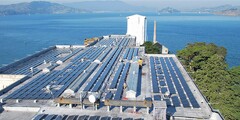Interior, Defense Departments Team Up To Build Renewables

Some military lands will still be used for other activities. | Photo: The California National Guard/Flickr/Creative Commons License
A steady supply of power is vital for the nation's security, and nowhere is this more true than on military bases. Each of the U.S. Armed Forces has committed to build a gigawatt of renewable power generation capacity on its bases by 2025, and the Defense Department is testing microgrids and storage technologies to keep their power on in case of disaster or attack.
And now, under an agreement announced today with the Department of the Interior, some of the Defense Department's land holdings may be considered for utility-scale solar, geothermal, and wind as well.
Related


10 Technologies Helping the Military Go Green

The Defense Department owns a lot of land in California: 3,812,558 acres, more than three quarters of that in the California desert. Much of that land is the kind of real estate the Interior Department has been eyeing for the last couple of years for renewable energy development: sunny, windy, and in large amounts.
Under the Defense-Interior memorandum of understanding (MOU) announced today, the military and the Interior Department will start a pilot inter-agency collaboration process for siting energy facilities on "suitable" Defense lands. In California, that will mean solar projects getting drawn up for the Red Lake and Goldstone areas in the Mojave Desert's Fort Irwin, as well as at that base's front gate north of Barstow. Projects are also planned at the Yuma Proving Ground and Barry Goldwater ranges in western Arizona.
Some of the military's land is owned outright by the Armed Forces, and some is "withdrawn" -- taken out of the public domain for use by the military. Each kind of land has its own permit process for projects such as utility-scale renewable energy plants. As the two kinds of land are often intermingled, problems can arise in planning any sort of energy development. The MOU commits the agencies to seeking legislative clarification of the withdrawn lands issue.
The two agencies also agreed to discuss the possibility of collaborating on offshore wind installations.
Don't look for massive development of renewable energy across entire military bases, however. The Armed Forces have consistently raised concerns about the effects of off-base renewable development on their own operations: the possibility that wind turbines may adversely affect low-flying aircraft, glare from solar facilities might impede pilots' vision, and electromagnetic interference from turbines might get in the way of communications and remote sensing have all been raised at one point or another as solar and wind facilities are proposed in our militarized deserts. One can only assume development on those military bases would be treated even more carefully.
ReWire is dedicated to covering renewable energy in California. Keep in touch by liking us on Facebook, and help shape our editorial direction by taking this quick survey here.


